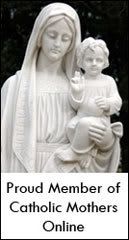HandyGramps Explains...
Now, let’s take a look at the specific changes that affect our participation in the Mass.
3. The Greeting & The Penitential Act
Before we look at the first two parts that have changed, let’s look at the word “liturgy”. It comes from a Greek word that literally means “the work of the people”. Liturgy is ritual prayer, a prayer that follows a prescribed form (called a “rite”, or “ritual”) with certain internal variations that do not alter the overall form. Liturgy is how we pray as a community, and the Mass is our highest form of prayer. Liturgy also includes the celebration of the Sacraments, Benediction, and the Liturgy of Hours, all of which follow a prescribed rite. Liturgy does not include private devotions – the Rosary, Stations of the Cross, the Litanies, etc. – which are, nonetheless, excellent in their own right for the simple reason that, when prayed with dignity and reverence, they lead us to the Eucharist.
Not only does liturgy follow form, liturgy also entails obligation – not merely the obligation to attend Mass on Sundays and holydays, but the obligation to take part in the Mass. We are not spectators, we are not a mere audience. With the priest, we are active participants in the unfolding drama of giving thanks and praise to God.
As we go along, you will note that many of the changes draw their text from the Bible. The appropriate scriptural passages will be noted. That said, let us begin…
The Greeting
Our new response to the priest’s greeting, “The Lord be with you” is “And with your spirit.” This is a richer, literal translation of the Latin, Et cum spiritu tuo, and is actually a restoration of the response used many years ago: P. Dominus vobiscum. R. Et cum spiritu tuo. Many non-English-speaking countries already use this more direct translation. The greeting expresses the fact that we are entering into the realm of the Divine, where Heaven meets Earth and “Sacrament happens”. The priest initiates the greeting with words drawn from both the Old and the New Testaments (Judges 6:12; Ruth 2:4; 2 Chronicles 15:2; and Luke 1:28). “And with your spirit” is drawn from four New Testament letters (Galatians 6:18; Philippians 4:23; 2 Timothy 4:22; and Philemon 25). It goes beyond a mere “Hi, there” or “Welcome”. It not only calls for the Lord to be present to our mortal selves, but reaches into the very core, the very spirit (there’s that word again) of our being.
Although seldom used, there are two other forms of the greeting by the priest: “The grace of Our Lord Jesus Christ, and the love of God, and the communion of the Holy Spirit be with you all” (based on 2 Corinthians 13:13) or “Grace to you and peace from God our Father and the Lord Jesus Christ” (Romans 1:7 and 1 Corinthians 1:3). Neither of these has been changed, but both elicit the restored response, “And with your spirit.”
The Penitential Act
There are three forms of the Penitential Act, the choice of which is up to the priest (or sometimes the deacon). The first is commonly known as the Confiteor, Latin for “I confess”. Two parts of the Confiteor have been changed.
Former Translation
“…that I have sinned through my own fault…”
Revised Translation
“…that I have greatly sinned…”
Former Translation
“…and I ask Blessed Mary…”
Revised Translation
“…through my fault, through my fault,
through my most grievous fault;
therefore I ask Blessed Mary…”
In the revision, our sense of the seriousness of sin is heightened, calling for a more sincere feeling of contrition. It reminds us to enter into the prayer of the Mass with a deeper humility and expectation of God’s forgiveness. The Confiteor will still conclude with the current formulary “Lord/Christ/Lord have mercy” with our appropriate echoed responses.
The second form, which for some reason is seldom used, is the most extensively retranslated Penitential Act. The scriptural sources for this act are Baruch 3:2 and Psalm 85:3. As you can see, the new emphasis on our sinfulness is not spoken FOR us by the priest, but BY us – which makes sense because each of us, not the priest, is responsible for our sins. Also, the revision maintains the communal dimension of sin by using the words “we” and “us” in our responses. As with the Confiteor, this form is followed by formulary “Lord/Christ/Lord have mercy”.
Former Translation
Priest: “Lord, we have sinned against You: Lord have mercy.”
Revised Translation
Priest: “Have mercy on us, O Lord.”
Former Translation
People: “Lord, have mercy.”
Revised Translation
People: “For we have sinned against you.”
Former Translation
Priest: “Lord, show us your mercy and love.
People: “And grant us your salvation.”
Revised Translation
Priest: “Show us, O Lord, your mercy.”
People: “And grant us your salvation.”
The third form, which is the most commonly used, consists of three tropes (invocations) to Christ (not to the Father), each followed by “Lord/Christ/Lord have mercy.” This form is not changed.
Keep in mind that these Penitential Acts are acknowledgements of our sinfulness and of God’s forgiveness. They are not sacramental in the sense of the Sacrament of Reconciliation.





0 comments:
Post a Comment